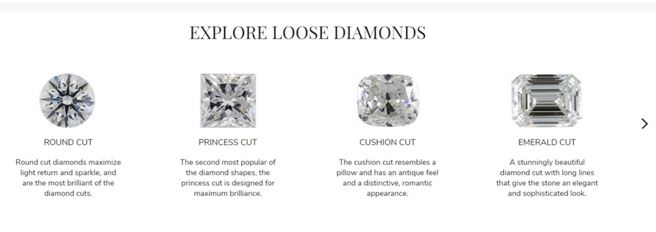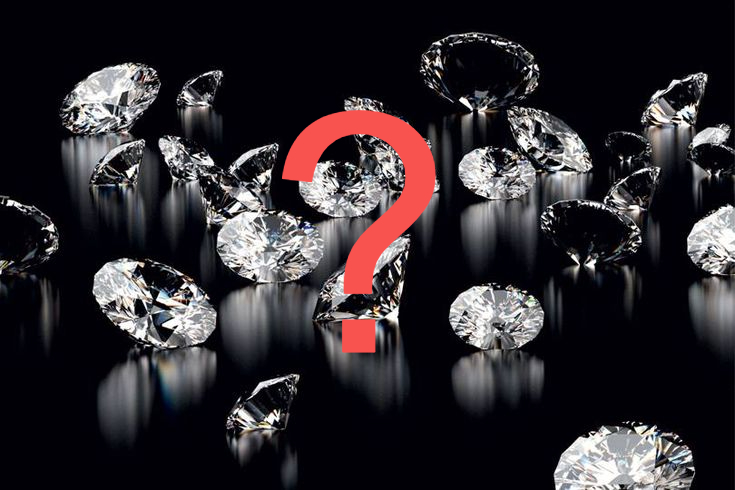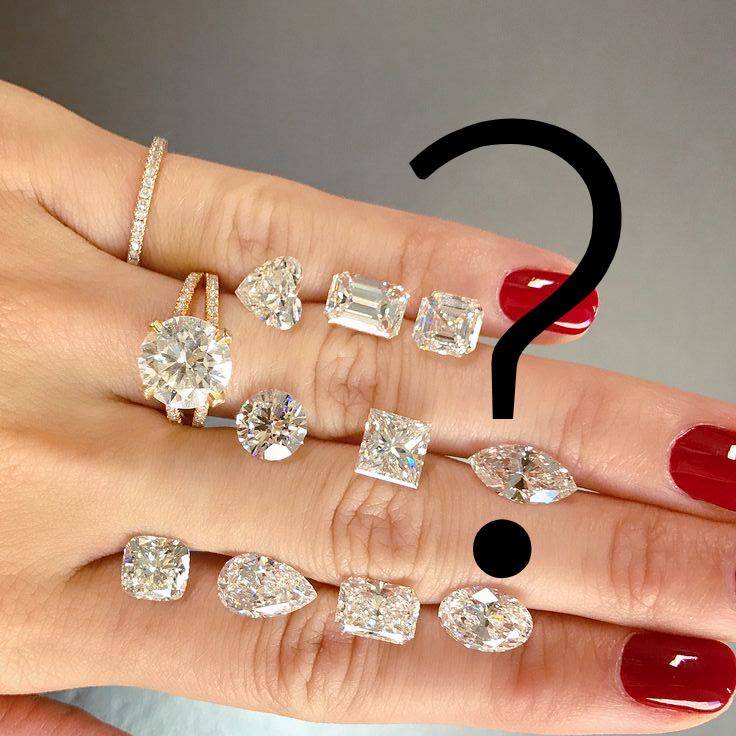The emerald cut diamond is considered to be among the first diamond cuts to be in existence. It is perhaps the oldest of all diamond cuts and other related precious stones. It constitutes a minimal percentage at about 3-4% of all diamond cuts present in the world today which poses the emerald cut diamond to be a very rare type of diamond cut. Emerald cut diamonds are also very distinct in their characteristics and are rectangular. The name is coined from the precious stone Emerald and the shape of this diamond conforms to the characteristics shape most emeralds come in. The history of this emerald shape can be dated back to as far as five hundred years old and one important feature of emeralds is that they are very susceptible and thus very complex as well as intricate to cut. This has prompted people to carve out diverse techniques to cut and polish this stone in the best possible way without compromising its quality and final shape outcomes. Of course, they have not been blessed with such knowledge and equipment we have today.
Emerald cut diamonds is emblems of beauty, elegance, and vigor. They are used prominently in most traditions today and it is cherished by many, thanks to its shape. Its capability to depict strength and quality more perfectly than other diamond cuts makes it a top pick for many celebrities and high-class brides. A right taste of poise this diamond cut is, for a bride who’s willing to rock her engagement without losing any bit of confidence. It is not, therefore, an overstatement to iterate the fact that emerald cut diamonds are elements of elegance and they do express a voice of archetypal vintage.
The emerald cut diamond comes in a rectangular shape and features shortened edges as well as a broad plane which are also usually flat. With these characteristics shape and edges, it bears a striking resemblance with a stair-step when looked at from the top. This style is commonly termed as a ‘step cut’. Moreover, the elongated shape it comes with makes this cut appear larger than it is. It is considered to have a larger surface area than the round brilliant type by 5% assuming they are of the same weight.
On a quick note, the emerald cut diamond is usually made up of 57 facets which imply that the crown makes up to 25 and for the pavilion, 32. However, it is important to note that the number of rows of the facets occurring on both the pavilion and the crown may usually range, thus changing the number of facets coming with this diamond cut.
For this type of diamond cut, its fire and brilliance are not as high as other cuts, but its clarity is quite exceptional. A great number of emerald cuts come with a length to width fraction within 1.3 and 1.5. For this length to width proportion, ratio 1.4 is mostly taken to be the most appropriate or ideal. For people who are more interested in a highly squared type will have to choose lesser ratios, but for those very much interested in having a more rectangular-shaped cut, they will have to opt-in for larger ratios. However, when emerald ratios fall above or beyond these ratios, they are usually considered uncommon and somewhat detested.
Emerald cut’s development
Where this cut originated from is still quite unknown, although its artistic characteristics can be exquisitely traced to the Art Deco period. Around 1920 to 1939, during the Art Deco period, the cut was of striking popularity and it was increasingly used by as many that could afford it. This largely due to its sparkling lines and a clean symmetry. More facets were being added to it. However, the emerald cut we know today got its original form around 1940. In this present period, the cut is more often used to depict and show off its cleanness and the beauty of the bright color it comes with. The cut is an embodiment of perfection and in its best form, it leaves no space for any flaws.
The emerald cut diamond itself was exquisitely created particularly for emerald gems, though it was employed for use with other gems with time, even diamond. The cut’s initial popularity can well be attributed to the fact that it needs just a little pressure when undergoing the cutting process. Its attractive appeal was eventually noticed by diamond cutters and they started adding it to diamonds also.
FACETS
The cut has ‘step cut’ facets which imply that it is in the same class of diamonds which the Asscher cut is. The name is derived from the way the facets are positioned in a step-like manner such that there are three rows of steps below and three above the stone. In all, the emerald cut diamond has 57 facets which are partitioned into twenty-four facets at the bottom, twenty-five at the above, and eight on the girdle. In essence, what determines the expected number of facets for an emerald cut diamond is the number of rows present on the pavilion and the crown. The breadth of the table is sufficiently wide and very bright. This thus makes the inclusion to be very obvious and easily seen. It is, of course, imperative for a quality stone as an emerald cut diamond to exhibit such a level of purity and clarity.
The emerald gives out some sparks of light that pose a kind of hall of mirrors effect and this is due to the step-cut facets it comes with. This thus creates some flashes of brilliant white light which is as opposed to the dark planes present in each step of the cut. It looks less intense and fiery but its sophisticated look is top-notch, thanks to the clean lines and the sparkling light flashes it gives off.
The cut is widely known as the most intricate cut, thus a diamond of sophisticated level of color and clarity is essentially required.
EMERALD CUT VERSUS ASSCHER CUT
The Emerald cut diamonds and the Asscher cut diamonds look a lot similar and can be confused for each other. They are both widely recognized for possessing a vintage sparkle as well as for their step cut faceting. It is easy for people who are just getting into the world of diamonds to confuse one for another; for those who are well versed about diamonds, it can at times be very difficult to differentiate between the two shapes. For many people, they generally consider the Asscher type is just a square emerald cut, but that’s not true.
One proven and fastest method to tell to differentiate between these closely related cuts is by the loose diamond’s shape. For emerald cuts, their shape is usually longer and rectangular while that’s not the case with the Asscher cut as it is square like in shape. Emerald cut possess a length to width ratio usually within 1.30 and 1.50, which lends to them a slimmer and elongated appearance. If the length to width ratio of an Asscher is within the 1.00 to 1.06 range, it will be completely squared or at least, appear very similar to as square.
Another point of difference between these two cuts is that they are carved differently. When cutting the Asscher, it is usually noted that they do not have a large table, unlike the emerald cuts. For emerald cuts, this wide table is just what gives them their posh and definitive appearance. It is also not difficult to notice inclusions and blemishes on emerald cuts and that’s why most people go for a higher clarity type of emerald cuts. Although Asscher cuts come with step cuts, they are also widely recognized for having increased faceting and an “X” pattern that is usually obvious when viewed from the top.
EMERALD CUT GRADE PROPORTIONS
The cut grade of an emerald cut diamond is representative of the quality of the ratio and symmetry of the diamond. The GIA and AGS do not designate any cut grade to this cut but the however designate symmetry and polish grades. This thus makes emerald cut’s grade to be determined by most retailers by its propositions, symmetry as well as its polish. This is because these parameters are good approximations of sparkle given that a true cut grade isn’t available.
Table% – Emerald’s cuts are considered poor, fair, good, very good, or excellent when they have their table percentage in the ranges < 51 or > 79, 51 – 53 or 75 – 79, 54 – 56 or 73 – 74, 57 – 60 or 70 – 72, or 61 – 69 respectively.
The depth percentage refers to how much light the diamond will reflect The depth percentage is indicative of the amount of light that the emerald cut diamond will readily reflect. As regards the depth percentage, the cut is considered poor, fair, good, very good, or excellent when it has < 54 or > 79, 54 – 56.9 or 74.1 – 79, 57 – 58.9 or 70.1 – 74, 59 – 60.9 or 67.1 – 70, or 61 – 67 respectively.
When it comes to girdle, a very thin to a fairly thick one connotes an excellent and very good cut. It is good when it is within very thin to thick, fair when within very thin to very thick, and considered poor when the girdle is within very thin to an extreme thick parameter.
When the cut has no cullet, it is considered excellent. The cut is very good when it has a very small cullet, good when it has small cullet, fair when it has medium cullet, and poor when the cullet falls any greater than medium.
LENGTH TO WIDTH RATIO
Emerald cut diamonds range in shape from almost square to as close to a slim rectangle. A length to width ratio around a value of 1.50 is unique to the emerald cut diamond. Perhaps, you are keen on having squared emerald, it is suggested that you check out the Asscher cut also, as it has an appearance that looks somewhat like a squared emerald cut. More so, the Assher cut, according to GIA, is specified to be a square-cut emerald. All Lumera Diamond are characterized by clear-cut dimensions and length to width proportion just to give you an exact clue as to the shape of emerald cut diamond that you are looking to go for.
The square type is considered excellent or very good if it has a length to width ratio falling within 1.00 to 1.o3, good when within 1.04 to 1.05, fair when within 1.06 to 1.08 and considered poor when the length to width ratio is greater than 1.08.
The rectangular choice is considered poor when the length to width ratio is less than 1.15 or greater than 1.90. It is fair when it is within 1.15 to 1.19 or 1.81 to 1.90, good when within 1,20 to 1.29 or 1.61 to 1.80, very good in the range 1.30 to 1.39 or 1.51 to 1.60, or considered excellent when it stands within 1.40 to 1.50.
COLOR
When it comes to examining color in this cut, it is more of a personal discretion thingy and individually biased. Be aware of the fact that most buyers may choose to go for the fairly warmer colors of the G-H diamond instead of the D-H type which is usually frigid colorless. Truth is that most emerald cut with color on the extreme side and with high price is usually steered largely by demand and supply. When customers are in dire search for the D-F color types, they are ready to pay more to get their hands on it. If the concept of color grading were not present at all, higher grade diamond will come at a lower premium price because the distinction between colors will be very hard to know. So, slight color differences will not be obvious and thus wouldn’t weigh at all on the scheme of things.
Usually, it is quite seamless to spot body-color differences when it comes to emerald cut diamond and this is due to the wide, open facets it comes with. Check out the color descriptions below as a guide for examining and choosing Emerald cut diamonds.
For less than 0.50 carats, the cut is considered excellent, very good, good, fair or poor if the color falls on D-G, H-I, J-K, L-M, or greater than M on the spectrum.
For 0.61 to 1.0 carats, the cut is considered excellent, very good, good, fair or poor if the color falls on D-F, G, H-I, J-K, or greater than K on the spectrum.
For 1.0 to 2.0 carats, the cut is considered excellent and very good, good, fair or poor if the color falls on D-F, G, H-I, or greater than I on the spectrum
For greater than 2.0 carats, the cut is considered excellent and very good, good, fair or poor if the color falls on D-F, G, H-I, J-K, or greater than K on the spectrum.
When there is an absence of fluoro, the cut is considered to be excellent, very good if with faint fluoro, good with medium fluoro, fair or poor when the fluoro is within the range strong-very strong.
CLARITY
Just as it is with color, dissecting clarity of an emerald cut diamond is usually very subjective. With the clarity grade made available by GIA, evaluating an emerald cut diamond in terms of clarity has never been made easier. However, it is imperative to bear in mind that each customer will choose between clarity ranges based on personal standards and discretion. Some customers might be good with the emerald cut diamond coming with inclusions so far it is not easily seen while some others may not be okay with that or any sort of technical blemishes or flaws. But with emerald cut diamond, inclusions are not so concealed and are thus usually quick to be noticed. While for other diamond cuts and shapes, having an SI1-clarity could be a perfect compromise of appearance and cost, VS2 could, however, be the corresponding best fit. The information on clarity below is going to give you a definitive clue and a guide to follow when determining clarity in this cut diamond.
A less than 0.50 carat emerald cut diamond is excellent if it has its clarity around FL to VS2. It is considered very good, good, fair or poor if it has its clarity on SI1, SI2, I1, or greater than I1 respectively.
For 0.51 to 1.0 carat emerald cut diamond, it comes as an excellent choice if it has FL to VS1 clarity. If the clarity is VS2, SI1, SI2, or greater than SI2, it is considered very good, good, fair, or poor respectively.
For 1.0 to 2.0 carat(s) emerald cut diamond, it is excellent, very good, good, fair, or poor if it has FL to VVS2, VS1 to VS2, SI1, SI2, or greater than SI2 clarity.
For Emerald cut diamonds with greater than 2.0 carats weight, it is considered excellent if it has FL to VVS2 clarity. It is very good if it has VS1 clarity. It is considered good at VS2 clarity. If it has clarity of SI1 or greater than SI1, it is considered fair or poor respectively.
COMMON SETTINGS FOR EMERALD CUT DIAMONDS
Because the emerald cut diamond comes with a unique elongated rectangle shape, it can be a difficult process finding the best setting that will complement its sophistication and style. It may require a bit of trial and error before the perfect setting and stone pattern can be achieved. Solitaire setting with a simple metal strip happens to be the most widely known setting and this is because it takes out the need to start looking for a kind of metalwork or another stone cut which will best suit the characteristics of the emerald diamond cut. The only thing left to worry about as regards setting is the choice size of diamond that suits your taste. However, having accent diamonds around the band instead of the metal strip is liked by many, thus making them go for a solitaire setting but with small diamonds filling up the band.
As a common rule, it is difficult to match emerald cut diamonds with the halo type settings. Nonetheless, when a little quantity of accent diamond constitutes the halo and small beaded metalwork making up the lining, the result is usually a classic, lovely emerald cut diamond with a vintage style. This particular style and pattern has been the most common choice for many people today and is a popular pick for engagements.



